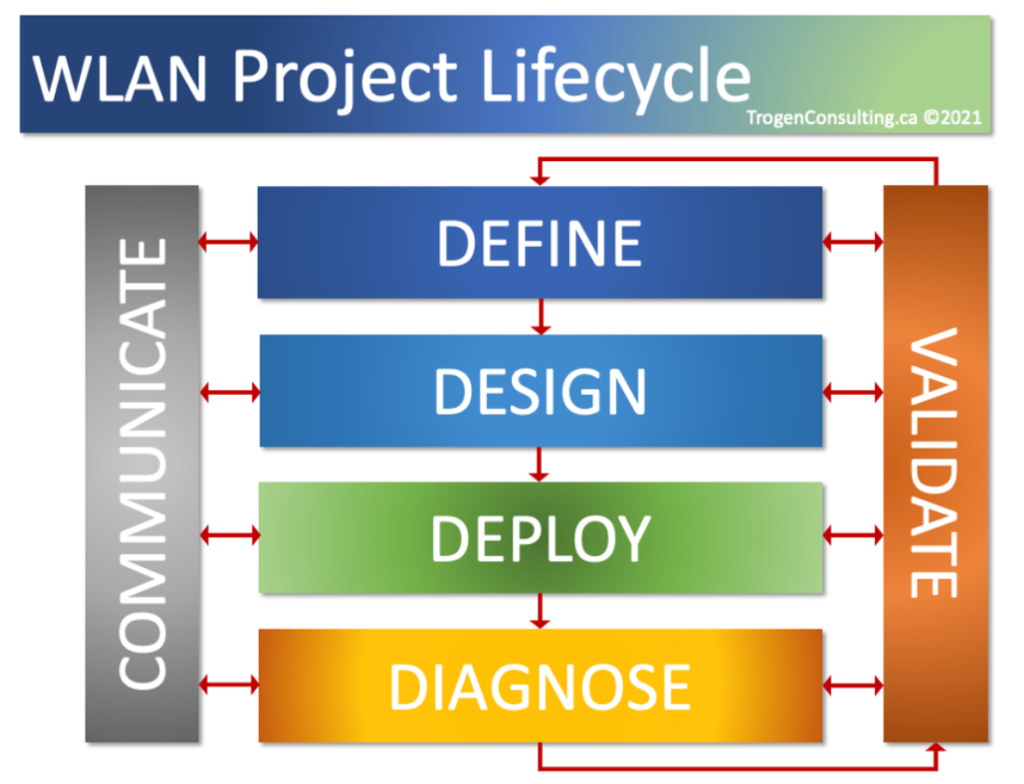Alternative WLAN Project Lifecycle

This is an alternative WLAN Project Lifecycle consisting of the following four core stages and two complimentary activities:
- Define
- Design
- Deploy
- Diagnose
- Validate
- Communicate
The WLAN Project Lifecycle can be entered via any stage. There is no defined start or end as the WLAN Lifecyle continually cycles through various stages. Each stage is optional; however, the lifecycle operates more efficiently if following the natural sequence once entering the cycle. Further to this, the same person, team, or company may not be responsible for delivering the full lifecycle as each stage may be completed independently.
A brief overview of each concept or state is described below. Future blog posts will expand on each concept in depth.
Define
This stage accurately defines and collects design requirements. Requirements should initially be stated in terms of business needs and later translated to, or expanded with, technical requirements. The most important question that should be asked at this stage is the question – “Why?”. Remember, customers are not interested in buying ¼” drills, what they want to buy are ¼” holes. Designers are often too quick to leave this stage and move ahead with design without fully capturing all of the requirements.
Design
Design is the stage in which solution(s) are creatively developed that solve or balance ALL requirements defined in the previous stage. Design is not limited to only the RF, but could also include network infrastructure, security, cloud, storage, virtualization, and end-device management to name a few. Developing multiple solutions allows designers to think outside the box and solve problems from multiple perspectives. Presenting stakeholders with options to meet their requirements fosters more discussion and clarification of understanding as well as building trust.
Deploy
During this stage, the ‘best’ design solution is implemented during the deployment stage which could include installation and configuration of hardware and software necessary to deliver the designed solution. Deployment may include network infrastructure, cloud or virtualization platforms, or end stations.
Diagnose
The diagnose stage has different goals based on the state of the WLAN lifecycle. Different goals include:
- tuning or optimizing a newly deployed WLAN solution,
- baselining or evaluating an already existing WLAN, or
- continual maintenance – baselining and turning a WLAN to address changes from: RF environment, firmware or software for clients or infrastructure, applications, number of users/devices, and so on.
Validate
Validation is performed at each of the four core stages to confirm accuracy of the requirements and any data shared. Capacity requirements, for example, are often over estimated and validating if the capacity requirements are in the realm of reason should always be performed, instead of blindly accepting those values as inputs in the design stage. Floor plans should be validated for accuracy to ensure the scale is correct and that the drawing matches the current layout. Sometimes walls have been added or removed and the drawings were not updated to reflect the changes. APs and antennas are validated to ensure correct placement and orientation. Infrastructure configuration is validated to ensure devices connect in the expected VLANs and subnets. Devices should successfully connect with expected authentication, authorization, and accounting logic in effect.
In short, validation is part of EVERY stage and may be performed iteratively throughout a single stage or at the conclusion of a given stage. Additionally, results from a validation may require revisiting a previous stage to collect more information or refine previous decisions.
Communicate
Communication is often overlooked or not effectively performed during the WLAN Project Lifecycle – therefore it is worth defining as its own concept or stage. Communication exists in many forms including verbal, physical, checklists, email, reports, budget, timelines, and schedules. Active listening strategies are key components to ensure all parties involved understand each other. This includes confirming mutual understanding by repeating back something another person has said, asking for clarifying details, or asking “why”.
To communicate efficiently with others, find a common lexicon. You are the expert, people don’t care about your gobbledygook or technojargon; adopt the language of others. This is a particularly important concept during the requirement gathering stage.
Slàinte!